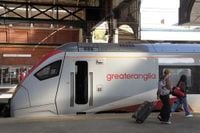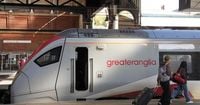On Sunday, October 12, 2025, Greater Anglia quietly transitioned into public ownership, marking a significant milestone in the United Kingdom’s ongoing effort to renationalise its passenger railways. The move, which took place with little fanfare but plenty of symbolism—cheesy decals and all—means that half of the country’s major rail operators are now in public hands, according to BBC and RailTech. It’s a shift that’s been coming for years, but for many, it still feels momentous. The Department for Transport (DfT) has described Greater Anglia’s transfer as “another step towards a more unified network of Great British Railways.”
Greater Anglia runs trains across large swathes of England, connecting Cambridge, Ipswich, Norwich, and Colchester to London, as well as serving Stansted Airport, Peterborough, Hertford, and numerous smaller lines. The company is widely recognised as one of the UK’s best-performing rail operators, recently winning the Passenger Operator of the Year award for the second consecutive year, as reported by BBC and East Anglian Daily Times.
The nationalisation is part of the Labour government’s broader plan to bring all major passenger rail services back under public control by 2027. The government’s approach has been methodical, taking over one operator at a time as contracts expire—avoiding hefty compensation payouts to private shareholders. Since May 2025, three operators—South Western Railway, C2C, and now Greater Anglia—have been brought into public ownership, with West Midlands Trains slated for takeover in February 2026. By the end of next May, 61% of journeys will be on nationalised trains, according to The Guardian.
This piecemeal approach is a deliberate response to the fragmentation caused by decades of privatisation, which, critics argue, prioritised profit over passenger experience. The government’s goal is to create a “single directing mind” for the railways, as the DfT puts it, through the establishment of Great British Railways—a state-controlled body that will soon oversee infrastructure and services across the network. Network Rail, which owns the tracks, signals, and major stations, will be integrated into this new entity, though the trains themselves will remain privately owned.
Transport Secretary Heidi Alexander, who visited Norwich train station last week to mark the transition, emphasised the government’s commitment to putting passengers first. “Passengers commuting into Norwich or heading for a day out in Cambridge will be travelling on services that are owned by the public and run with their interests front of mind,” she said, as quoted by BBC. “We’re reforming a fragmented system and laying the foundations for a more reliable, efficient and accountable railway – one that puts passengers first and delivers the high standards they rightly expect.”
Greater Anglia’s managing director, Martin Beable, echoed this optimism. “Moving into public ownership is an exciting opportunity to build on this success,” he said. “By working more closely with the wider family of publicly owned operators, we can share expertise, drive innovation and deliver even better journeys for our passengers across the Anglia region. This transition also brings us one step closer to Great British Railways—a simpler, more unified network that puts passengers at its heart.”
Not everyone is convinced nationalisation will solve all the network’s woes. Trevor Garrod, chair of the East Suffolk Travellers Association, expressed cautious optimism. “We are not worried about the nationalisation, but quite clearly bodies like our own will continue to exist and hold to account the operators and politicians,” he told the East Anglian Daily Times. Garrod highlighted unresolved issues for east Suffolk passengers, such as the long-promised but undelivered “through trains” to London and the need for the East West Rail project between Oxford and Cambridge. “The government is now more conscious about the need for an effective rail network, especially due to the impact of climate change and the desire to encourage more travellers to move away from more carbon-emitting forms of transport, such as the car or plane,” he added.
The government’s Plan for Change aims to address such concerns by making the railway more accountable, efficient, and reliable. The DfT has stated that Greater Anglia will “continue to thrive” under public ownership and serve as a benchmark for other operators. Industry insiders, however, warn that nationalisation alone may not be enough to fix all of Britain’s rail problems, given ballooning costs and the sector’s reliance on public subsidy. Stephen Glaister, emeritus professor of transport and infrastructure at Imperial College London, told The Guardian, “Irrespective of the ownership changes, the government’s got a major headache with the fact that rail is gobbling up so much public subsidy, and that’s before you get to HS2.”
In fact, the government is currently providing £12 billion in operational subsidy, with additional billions allocated for projects like HS2 and other infrastructure investments. While Labour has pledged to make fares more affordable and services more reliable, these improvements will require significant public investment. Rail fares have risen faster than average earnings since privatisation, and the cost of a typical journey has increased in real terms. Last year was also the worst for cancellations since 2015, according to the Office of Rail and Road.
Some experts see promise in the efficiencies that might come from integrating track and train under a single public entity. Marcus Mayers, managing director of the Rail and Station Innovation Company, explained to The Guardian, “It’s possible, because there’s efficiencies of integration of track and train, which might mean that problems get solved more quickly. You may be taking out the commercial imperative to drive reliability, but you’ve also got more collaboration about how to achieve it. So it’s a fine balance, and whether it will work or not is still open for debate.”
Others remain sceptical about how much more can be squeezed from the system. “Governments frequently say: ‘Oh, we’ll make the railways more efficient, we’ll buy lots of new equipment, we’ll employ less people to do the work,’” Glaister said. “But the industry has been trying to do that for years and years, and the regulators screw that down to the absolute bottom in their settlements. And I don’t think there’s a lot of, as it were, undiscovered efficiencies to go for.”
The transition to public ownership has not been without its hiccups. Just a day before the handover, cable theft at Shenfield in Essex caused signalling errors and disrupted Intercity trains between Ipswich and London Liverpool Street, as reported by BBC. Such incidents highlight the ongoing challenges facing the network—issues that will require more than a change in ownership to resolve.
Meanwhile, the broader rail landscape is evolving. Italian state-owned company Ferrovie dello Stato Italiane (FS) has expressed interest in bringing international trains back to Kent, with plans to reopen Ashford International Station and start services to Paris by 2029, according to Kent Online. In North Wales, new direct services from Llandudno to Liverpool are set to begin in May 2026, promising to strengthen regional ties and improve connectivity, as reported by Wales 247. Infrastructure upgrades, like the £3.3 million reconstruction of Chesterfield Railway Station’s platforms, are also underway to boost capacity and reduce maintenance costs.
As the government marches steadily toward its 2027 deadline for full rail nationalisation, the question remains: will public ownership deliver the reliable, affordable, and passenger-focused railway that Britain’s travellers have long demanded? The answer, for now, is unfolding one operator—and one journey—at a time.






